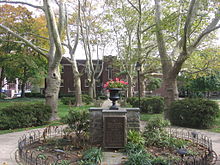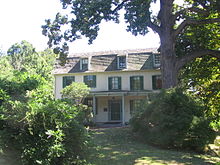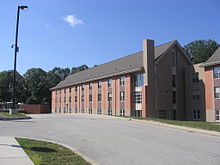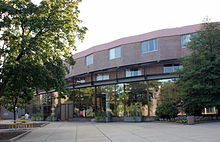- La Salle University
-
For other uses, see La Salle University (disambiguation).
Coordinates: 40°02′21″N 75°09′12″W / 40.03925°N 75.15325°W
La Salle University 
Latin: Universitas La Salliana Motto VIRTUS SCIENTIA
(Virtue, Knowledge)Established 1863 Type Private Endowment $55 million[1] President Bro. Michael McGinniss Academic staff 373[2] Undergraduates 4,773[3] Postgraduates 2,781[3] Location Philadelphia, Pennsylvania, U.S. Campus Urban, approximately 130 acres (501,809.4 m²) Colors Dark Blue and gold Athletics 23 NCAA Division I varsity teams
Go Explorers!Nickname Explorers Mascot The Explorer Affiliations Christian Brothers. (Academic)
A10 (Athletic)Website http://www.lasalle.edu/ 
La Salle University is a private, co-educational, Roman Catholic university located in Philadelphia, Pennsylvania, U.S. Named for St. Jean-Baptiste de La Salle, the school was founded in 1863 by the Institute of the Brothers of the Christian Schools. As of 2008 the school has approximately 7,554 students, about 63% of whom are undergraduates. The 2009 freshman class was the largest in nearly 30 years.[4] Located in northwestern Philadelphia, the university is affiliated with the Roman Catholic Church through the Archdiocese of Philadelphia. Its name is commonly misspelled or represented as "LaSalle", omitting the proper space. The comprehensive cost for a year of tuition is $42,850.[2]
Contents
History
La Salle College was founded in March 1863 as an all-male school by Brother Teliow and Archbishop James Wood of Archdiocese of Philadelphia. It was first located at St. Michael's Parish on N. 2nd Street in the Olde Kensington section of Philadelphia. La Salle soon moved to the building vacated by St. Joseph's College at 1234 Filbert Street in Center City, Philadelphia. In 1886, La Salle moved to a third location, the former mansion of Michael Bouvier, the great-great-grandfather of Jacqueline Kennedy Onassis, at 1240 North Broad Street. La Salle finally moved to its current campus at the intersection of 20th Street and Olney Avenue in 1930. The new location had a suburban feel with ample land, but was linked to the city by trolleys and the newly constructed Broad Street Subway.
The 1930s proved to be a tumultuous decade for La Salle, which was nearly bankrupt. The main academic building on campus, College Hall was unable to be finished due to a lack of funds, and the college nearly closed in the late-1930's. The school's closing was prevented by a 75th Anniversary Fund Drive in 1938, spearheaded by Philadelphia businessman John McCarthy. Funds raised from this drive also enabled La Salle to purchase a tract of land to the east of 19th Street, where Philadelphia had intended to build a city college.
La Salle nearly closed again due to a lack of students during World War II, and the football team was disbanded due to a lack of players, but the school experienced a period of growth in the late-1940's. Several new buildings were constructed in the 1940s and 1950s, including a new library, student union, and a science building. It was also during this time that the first student residence halls were constructed at La Salle, mostly on land purchased from the former Belfield Country Club. Additional student housing was provided by purchasing or renting local homes, such as the house known as "The Mansion", on David and Logan Blain's Belfield Estate.
La Salle admitted women to its regular classes in 1970, becoming a fully co-educational institution. A year later, La Salle opened Olney Hall, its main academic building. It also continued to expand its property throughout the 1970s and 1980s, buying land along Chew Avenue, along with the Belfield Estate in 1984, and to the south of main-campus, the orphanage run by the Sisters of St. Basil the Great. It was also during this era, in 1984, that La Salle was granted University status. Recently, La Salle has acquired the former Germantown Hospital, now West Campus, and constructed The Shoppes at La Salle shopping center across the street in 2008.
Academics
La Salle offers undergraduate concentrations in nearly 60 academic areas within its College of Professional and Continuing Studies and its three Schools: Arts & Sciences, Business Administration, and Nursing & Health Sciences.
Communication, Nursing, and Education are the largest majors at La Salle.
Several new and distinctive high-tech majors include Integrated Science, Business and Technology (ISBT) and Digital Arts and Multimedia Design (DArt). The College of Professional and Continuing Studies offers three accelerated cohort programs in Business Administration, Corporate Communication, and Organizational Leadership.
The university also offers master's degrees and doctorate degrees in several courses of study. Every undergraduate, regardless of school or major, must complete a strict Core curriculum in order to graduate. Offering sustained study in a broad range of disciplines, the Core curriculum provides students with an opportunity to build a strong educational foundation for the future. Guided by La Salle's heritage as a Catholic university, the core curriculum reflects La Salle's strong commitment to the interdependence of intellectual and spiritual growth. Its aim is to help students find an engaging living as part of an engaged life. As future competitors in a rapidly re-forming world, students need intellectual resources that keep pace with current innovations; as future innovators, students need spiritual resources that guide human beings towards humane reforms.
Undergraduates must complete the three facets of the Special Core Programs, as well as courses within the three Course Objectives.
Special Core Programs
The Special Core Programs consists of the Doubles Program, First Year Odyssey, and Understanding at Home and Abroad.
- In the Doubles Program, all students are required to enroll in a "Double" during their freshman year. Doubles are thematically linked Core courses in different disciplines. In the Doubles program, students will explore some or all of the topics in these courses under the guidance of two professors. A sense of academic and social community forms.
- The First Year Odyssey is a one-credit program, which introduces students to La Salle University and the city of Philadelphia through activities such as field trips and campus wide programs. Students participate in the First Year Odyssey as part of designated courses or in special First Year Odyssey sections.
- Understanding at Home and Abroad refers to fostering the Christian Brothers' ideals of community, social justice, and compassionate understanding across barriers dividing human beings. Students are required to enroll in one course in the Academic Bulletin designated by the symbol of a "house" (Understanding at Home) and one course designated by the symbol of a "plane" (Understanding Abroad). Some students may fulfill the Understanding at Home or Understanding Abroad requirement through an independent project with the approval of the Department Chair and the Core Director. Faculty and staff will mentor a limited number of such projects.
Course Objectives
The Course Objectives consist of the Powers, Frameworks of Scientific Understanding, and Patterns of Meaning.
- Powers refers to competencies that enable students to learn, to think, and to communicate. With this course work, students will emerge from the core curriculum possessing a strong set of skills in reading, writing, oral communication, and mathematics. They will also learn how to use computer technology to aid their work in each of these areas. These competencies will be integrated in courses in all areas of the Core, but will be taught directly in courses in writing, public speaking, mathematics, and computer science.
- Frameworks of Scientific Understanding refers to concepts and methods learned in courses in the natural and social sciences. In these courses students will become familiar with the scientific method and sharpen their understanding of the natural processes and the social developments, which shape the world in which we live. The "Frameworks of Scientific Understanding" category includes courses in economics, political science, psychology, sociology, biology, chemistry, geology, and physics.
- Patterns of Meaning refers to a set of capacities students must acquire to engage the moral, aesthetic, and spiritual significance of human events and achievements. Courses in the humanities (religion, philosophy, literature, history, fine arts and foreign languages) will enable students to develop these capacities.
Course Requirements
All courses in the core may be counted towards any minor or major barring exclusions by the academic departments sponsoring the minor or major. To complete the Core requirements, most School of Arts and Sciences majors must complete a maximum of 19 courses; School of Business Administration majors, a maximum of 16 courses; and School of Nursing and Health Sciences majors, a maximum of 15 courses.
Athletics
Main article: La Salle ExplorersSee also: Men's Basketball, Football
La Salle University's 23 varsity sports teams, known as the Explorers, compete in the NCAA's Division I and are a member of the Atlantic Ten Conference. The name derives from a 1931 mistake made by a sportswriter. The writer thought the university was named after the French explorer Sieur de La Salle, when in fact it is named after St. John-Baptiste de la Salle and was officially chosen in a student contest during the spring of 1932.
La Salle's teams have won two national championships: The 1954 NCAA Men's Division I Basketball Tournament and the 1980 Division II AIAW Field Hockey Championship. The school also won the 1952 National Invitation Tournament. La Salle's major historic rival has been the Hawks of the Saint Joseph's University, especially in men's basketball. Not only are both schools situated in Philadelphia, but they are also both Catholic, private institutions.
Campus
La Salle moved to its fourth and present location in 1931. The campus is located in part on Belfield, the estate of Charles Willson Peale, the Revolutionary War patriot and painter famous for his portraits of the founding fathers, most notably, George Washington. His home is the current office of the University president and is possibly the oldest building currently in use by any university in the nation.
La Salle has an art museum located in the basement of Olney Hall that houses a collection of European and American art from the Renaissance to the present. The museum also owns a number of special collections including rare illustrative Bibles and Japanese prints. The art museum is also home to the “Walking Madonna” one of four by the British artist Dame Elisabeth Frink. Frink created the sculpture in 1981, the other “Walking Madonna” sculptures remain in England, with one in Salisbury and the other in Frink’s garden at her home.
A satellite campus and Conference Center in Newtown, Bucks County, Pennsylvania, the La Salle University Bucks County Center, offers graduate courses in various disciplines, undergraduate courses in nursing, and continuing education courses. The Conference Center comprises fifteen instructional rooms with seating capacities ranging from 20 to 40, along with four computer laboratories with 100 workstations.
La Salle also offers M.B.A. and Clinical-Counseling Psychology M.S. classes at the Plymouth Meeting Metroplex Corporate Center in Montgomery County, Pennsylvania.
Food
La Salle has two dining halls, one on each end of campus. The newer Treetops Cafe is on south campus next to St. Basil Court and St. John Neumann Residence Halls and is open seven days a week. The Blue and Gold Commons, located on Olney Avenue, next to the North Residence Halls Complex, is only open on weekdays. In both of these dining halls, one may purchase food with a meal plan, Food Account Money, or cash. In the La Salle Student Union is The Union Food Court, which has several "store fronts". Each of these "store fronts" specializes in a certain type of food, including pizza, burgers, baked goods, sandwiches, salads, and international cuisine. Unlike the other two dining facilities, meal plan is not accepted.
La Salle also offers other food options such as the Blast Smoothie Bar, and Intermissions, a late night dining facility, both of which are in the Student Union. La Salle owns and runs The Explorers Den, a cheesesteak, pizza and burger shop located on the 2100 block of Olney Avenue.
Student Housing
Since 1953, La Salle has hosted resident students. There are several student housing complexes: North Residence Halls, Sts. Edward and Francis Residence Halls, St. Miguel Townhouses, St. Teresa Court Apartments, La Salle Apartments, and the South Campus Residence Halls (St. Basil Court and St. John Neumann).
Student life
Students at La Salle are offered many varied opportunities to participate at different degrees and in many different ways. There are several organizations and a student programming center whose mission is primarily to plan activities (games, movie nights, bus trips, etc.) for the students of La Salle University. The Communication Department operates La Salle 56, a cable TV Educational-access television station available to 300,000 subscribers. The university also has a student-run radio station, WEXP along with over 100 other [5] intramurals, clubs, and NCAA division I sports offered.
Greek life
One of the aspects of La Salle's social scene are its fraternities and sororities. La Salle's Greek community consists of five sororities (Alpha Theta Alpha, Alpha Sigma Tau, Gamma Phi Beta, Gamma Sigma Sigma, and Delta Phi Epsilon) and seven fraternities (Alpha Phi Delta, Sigma Phi Epsilon, Alpha Chi Rho, Delta Sigma Phi, Sigma Phi Lambda, Phi Beta Sigma, and FIJI).
"Day ONE"
The first day of a student's time at La Salle occurs at the orientation program called Day ONE, which stands for Orienting New Explorers. The day consists of giving essential information to new students and their families, but its primary objective is to build relationships: relationships between the new students and other new students, between the new students and their upper division student hosts, between new students and administration and faculty, and between the students' families and the school.
Sessions
During the orientation students make their schedule, get their photo taken for their ID, and participate in discussion sessions about important information. Resident students get a presentation on living on campus and see a residence hall, while commuters see a similar presentation about getting involved while living off campus. The other important aspect of this day in the introduction of The Affirmation, which is read line by line and discussed throughout the different sessions of the day.
Philosophy
Learning, Involvement, Community, Relationships
Learning is the reason students attend La Salle in the first place. Involvement is the mechanism through which learning can happen. Community provides the environment that most strongly promotes involvement. Making strong relationships is the first step toward forming a community.
Distinguished accomplishments
- La Salle has graduated 58 students who have been named Fulbright Scholars.[3]
- A nearly perfect 98 percent of La Salle's applicants to medical school who have been recommended by the pre-medical committee have been admitted to medical school.
- La Salle ranks 7th out of 253 schools of its type as the undergraduate point of origin of doctoral degree recipients over a 75-year period.
- La Salle is one of only 19 colleges and universities in the nation to have been invited to participate in the Kemper Scholars Program.
- La Salle graduates have won nine Emmy Awards.
- More than 1,700 La Salle students annually donate more than 100,000 hours of community service in activities including neighborhood cleanups, rebuilding homes, and tutoring.
- La Salle's chapter of Beta Gamma Sigma, the international business honor society, was named the outstanding chapter in the world in 2004.
Expansion and Master Plan
La Salle has worked with Philadelphia architecture firm H2L2 to assist in the development of a Campus Facilities Master Plan, building upon a previous plan completed by the University in 1985. Key components of the Master Plan are the following: New Science and Technology Building, New Athletic Arena, Student Recreation Center, additional student housing, Dining Hall, Chapel, Fine Arts and Theater Building, parking garage, and additional commercial activity.
Accommodating the above facilities while orchestrating seamless connections between the disparate areas of the campus is one of the Plan's greatest accomplishments. Topography, city streets, and heavy traffic, all initially appeared as impediments to the development of a true campus. Improved vehicular and pedestrian circulation patterns now yield enhanced links to memorable spaces, uniting this Campus into one whole, while satisfying all programmatic requirements.[6]
In the Fall of 2005, the $26 million dollar first phase of this master plan was completed with the construction of Tree Tops Cafe (dining hall) and St. Basil Court (Residence Hall).[7]
St. Basil's houses approximately 430 students. Three of the building's wings feature "suites", in which four students share two bedrooms and one bathroom. The fourth wing's rooms have the traditional one-room for housing two students with communal bathrooms. The facilities have lounges, study rooms, and special purpose rooms. Basil is the only co-educational dorm at La Salle in which both genders may live on the same floor (albeit not in the same room).
A $2.5 million dollar athletic field renovation was completed in the Fall of 2006.[8]
In May 2007, the university purchased adjacent Germantown Hospital for $10 million dollars. The 24 acres (97,000 m2) acquired has become "West Campus", and increased the campus size by 25 percent.[9]
A $15 million dollar shopping center and supermarket complex opened in Fall 2008.[10]
Phase two is the completion of the New Science and Technology Building. The University has revealed that they have already raised $20 million dollars towards the $25 million necessary to complete the facility [1]. It was completed in Fall 2009.
Alumni
Main article: List of La Salle University PeopleSee also
References
- ^ http://www.nacubo.org/Documents/research/2009_NCSE_Public_Tables_Endowment_Market_Values.pdf
- ^ a b Petersons.com College Overview
- ^ a b c lasalle.edu: Just the Facts
- ^ La Salle University Welcomes More Than 1,800 New Students to Campus
- ^ Student organizations
- ^ La Salle University Master Plan
- ^ La Salle University to Hold Groundbreaking Ceremony for New $26 Million Residence Hall and Dining Facility
- ^ Athletic Fields to Undergo $2.5 Million Facelift
- ^ La Salle University Buys Einstein’s Germantown Hospital Property
- ^ Supermarket, Shopping Center Plans Announced by La Salle and Partners
External links
LA SALLE UNIVERSITY Academics Schools: School of Arts and Sciences • School of Business Administration • School of Nursing & Health SciencesAthletics A10 • Explorers • Football • Hank DeVincent Field • Hayman Center • McCarthy Stadium • Men's Basketball • Tom Gola Arena • Wakefield ParkCampus Art Museum • Benilde Tower • Carriage House • Christian Brother's Residence • College Hall • Connelly Library • David Leo Lawrence Administration Center • Holroyd Science Center • Japanese Tea Ceremony House • McShain Hall • Olney Hall • Peale House • Philadelphia • Wister HallStudent life AIDS Outreach • Alliance • Anime Club • APD • AST • AXP • CARE • Circle K • The Collegian • DSP • DPE • Explorers for Life • FIJI • FOCUS • Foster Care Tutoring • GPB • GSS • Interfraternity-Sorority Council • La Cycle • La Salle 56 • Neighborhood Tutoring • PBS • RSA • SGA • TKE (not recognized) • SPE • WEXPMiscellaneous Categories:- La Salle University
- Lasallian educational institutions
- Roman Catholic universities and colleges in the United States
- Middle States Association of Colleges and Schools
- Universities and colleges in Pennsylvania
- Universities and colleges in Philadelphia, Pennsylvania
- National Association of Independent Colleges and Universities members
- Pennsylvania Main Line
- Museums in Philadelphia, Pennsylvania
- Art museums in Pennsylvania
- University museums in Pennsylvania
- Educational institutions established in 1863
Wikimedia Foundation. 2010.














